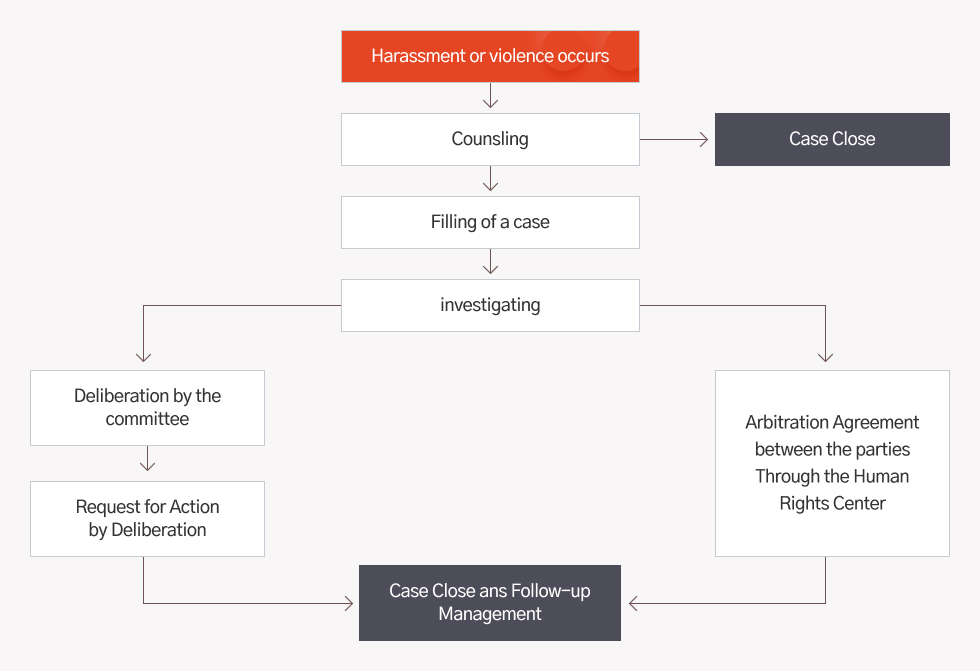Student Sexual Harassment Help Desk
Help Dest for sexual harassment
and sexual violence
and sexual violence
UST operates a counseling center for sexual harassment and sexual violence to protect
the human rights of its members.
What is “sexual harassment”?
- In general, the term "sexual harrasment" means making the other party to feel sexual humiliation or aversion with verbal or physical behavior of a sexual nature, sexual demand, etc.
- The legislation cases defining the concept of the sexual harassment can be found in National Human Rights Commission Act, Act on Equal Employment and Support for Work-Family Reconciliation, and Framework Act on Gender Equiality. It elaborates on the sexual harassment as making the other party feel sexual humiliation or aversion with verbal or physical behavior of a sexual nature, sexual demand, utilizing his/her position or in relation with his/her duties, or expressing one's intention to put the other party at a disadvantage on grounds of not complying with any verbal or physical behavior of a sexual nature or other demands or to grant him/her any benefit on condition of complying therewith.
| Relevant Legal Provision | Definition of Sexual Harassment |
|---|---|
| Paragraph 3 , Article 2 of the National Human Rights Commission Act | The term "sexual harassment" means that the working persons, employers or employees of a public agency make others feel sexually humiliated or loathsome by their sexual comments, etc. or giving others disadvantage in the employment on the pretext of disobedience to sexual comments, other demands, etc., by taking full advantage of their superior position or with regard to the duties, etc. |
| Paragraph 2, Article 2 of the Act on Equal Employment and Support for Work-Family Reconciliation | The term “sexual harassment at work” refers to a situation where an employer, a superior, or a worker causes another worker to feel sexually humiliated or offended by sexually charged words or actions by using their position in the workplace or in relation to work, or gives disadvantages in employment for disregarding sexual words or actions or any other demands, etc. |
| Paragraph 2, Article 3 of the Framework Act on Gender Equiality and Article 2 of the Enforcement Decree of Framework Act on Gender Equiality |
|
Representative Types of Sexual Harassment
Physical conduct
- Physical contact such as kissing, hugging, or embracing from behind
- Touching specific body parts such as breasts or bottom
- Forcing actions such as caress or massage
Verbal conduct
- Dirty jokes (Includes phone calls)
- Making a sexual remarks or evaluation about appearance
- Asking about the details of someone’s sex life or intentionally spreading information that has sexual contents
- Forcing or asking for a sexual relationship
- Forcing someone to sit next to oneself and making him/her pour drinks at department or session meetings
Visual conduct
- Showing pornographic pictures, photo, graffiti, images (including computers and cellphones)
- Deliberately showing particular body parts and touching them
Actions to Take against Sexual Harassment
Clearly indicate your refusal
- Most sexual offenders claim that their conduct was an expression of intimacy. If you do not indicate your refusal, they may mistakenly think that you are enjoying the situation or have agreed to such actions. So when being sexually harassed, you have to express your refusal very clearly.
- When it is difficult to show refusal, leave the place or display your uncomfortable feelings.
- The initiator must take this refusal seriously and stop his/her actions immediately.
How to refuse
- Clearly state how much the conducts make you uncomfortable and that it is disturbing your work, and also clearly state what you want.
- When doing this through a letter, describe the conduct of the offender according to the 5W1H method (Who, What, When, Where, How, Why) and make sure that the feelings and thoughts are described clearly.
Contents related to the case must be documented or recorded as evidence
- When the sexual harassment continues even if the victim clearly refused, he/she must record or write down the date, time, location, the specific conduct, witness, as well as the feelings you got from the harassment. This record can be used as evidence when getting help.
- Witness testimonies must be recorded or written on paper as well.
Sexual Harassment Help Desk
What is the role of the Help Desk?
- Advising or counseling for victims about the affairs regarding sexual harassment, and receiving sexual harassment complaints
- Conducting investigation and responding to sexual harassment cases
- Adjusting cooperation among departments in order to process the sexual harassment case
- Making and implementing the plan for preventing recurrence of sexual harassment
- Conducting programs and advertisements in order to prevent sexual harassments
How can I report the case?
Operation of Grievance Committee of Sexual Harassment
The operation and procedure of the grievance committee for sexual harassment complies with the UST Regulations for Prevention of Sexual Harassment
Composition of the Committee Composition
Total 6 members including the chief of the committee and
Role of the Committee
- Handling of sexual harassment and sexual violence cases(including secondary damage)
- The expression of opinions, such as determination, mediation, disciplinary action, etc. of sexual harassment and sexual violence
- Other necessary measures to prevent sexual harassment and sexual violence and to prevent recurrence
Deliberation Procedure of the Committee
-
01Receiving the complaint(Human Rights and Counseling Center)
-
02Refer the problem to the committee
-
03Deliberation and resolution(Committee)
-
04Final approval(president of UST)
-
05Relief measures for the victim and disciplinary action against the offender

List of External Consultation Institutions for Sexual Harassment Victims
Related Homepages
Related phone numbers
- Emergency call for woman/Area code +1366, National Human Rights Commission of Korea ☏1331
- Seoul counseling center for Migrant Women ☏ 02-733-0120